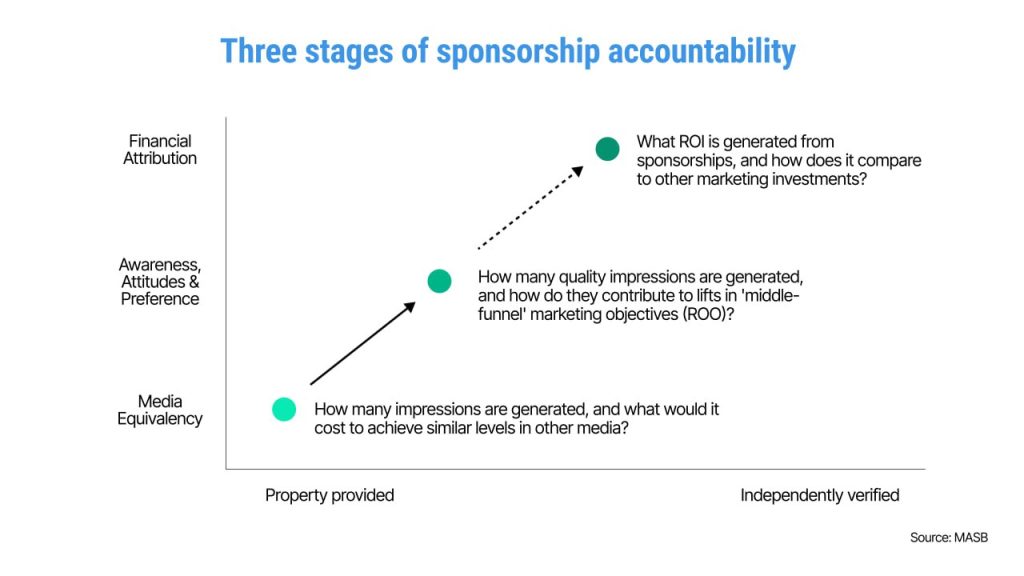
Brands invest billions of dollars in various events every year worldwide, but only few of them know how to measure the return they get. In this article we will see why calculating media equivalence is not enough and learn about other approaches to measuring the effectiveness of sponsorship deals.
Sponsorships give brands unique opportunities for deep customer engagement and access to huge audiences, but like with other investments their effectiveness needs to be evaluated to make sure the money is not wasted. Measuring sponsorship effectiveness has been a serious challenge for CMOs. According to a research by MASB (Marketing Accountability Standards Board) and ANA (Association of National Advertisers), 40% of marketers don’t even make attempts to do it, and 70% of companies don’t allocate enough money for the necessary market research and measurements. It happens because some brands are just starting to adopt the discipline of budgeting, or they don’t have a clear sponsorship strategy and need to manage a portfolio of deals with different objectives. Another issue is the lack of tools that can cope with the task. In this article we will cover key metrics to track and tools that can be used to measure sponsorship effectiveness.
The first step to achieving accurate measurement results is sufficient funding for the task. Forbes recommends assigning to measurements 1-2% of the sponsorship budget if its size is significant and no less than 5% for smaller ones. To make sure the money isn’t spent on activation or something else, measurement budget share should be clearly stated in the business case for sponsorship and protected as long as the deal lasts. The next steps are to develop a clear strategy, create a business case, and follow the recommendations on improving sponsorship accountability from part 1. By doing so, you will be one step closer to understanding how effective your sponsorship is.
What can be measured?
There is a number of parameters a company can evaluate depending on its objectives, resources and measurement maturity. The graph below shows three stages of sponsorship accountability maturity corresponding to what is measured.

Media equivalence or media value is the most commonly used metric because it’s the easiest one to measure. It shows how many impressions are generated by the sponsored event and how much it would cost to achieve the same amount of impressions by investing in other media. In many companies this is the only aspect marketers are able to put on their reports on sponsorship effectiveness. To make the most of this simple approach different values can be assigned to various media assets provided by the property depending on logo size or exclusivity. Keep in mind that media equivalency only reflects exposure, not impact, that’s why it should be used as a supplementary tool to understand whether an event is worth investing in. Today companies are moving away from this approach towards more advanced analytics.
Return on Objectives (ROO) is a critical effectiveness parameter, that demonstrates if an activity leads to the desired objectives. It evaluates changes in consumer attitude and behavior, by monitoring a number of metrics. The most important of them is brand preference because it has a high correlation with market share and price premiums. A study of 200 brands in different categories by MASB proved that brand preference has a stronger relationship to sales than other metrics examined. It’s a pretty universal measure that can be applied to campaigns with different objectives, unlike awareness, which is not fitting when an activity is targeted at old customers. Brand preference also ranks above other metrics and captures their impact on sales too, which makes it perfect for managing a portfolio of sponsorships.
Being able to measure ROI of sponsorships is the ultimate goal of marketers, but the task is challenging because other promotional activities running in parallel also contribute to sales. The hardest part is isolating financial output of sponsorship that aligns with the brand objectives. If your company has the necessary resources for conducting ROI measurement, make sure to measure the return on all sponsorship spends. It is even better if a brand can link ROI and ROO measures by identifying a relationship between financial results and customer attitude changes. And ideally, marketers should be able to balance a whole portfolio of deals in terms of reached audience and strategic objectives.
When to measure?
According to the research, marketers are most satisfied with measurements taken before and after a sponsored event, while measurements occurring during an event need to be improved. Anyway all three stages are important to ensure better understanding of results and optimization. The best approach is to align the measurement process with the sponsorship strategy.
How to measure?
Information about media equivalence is usually provided by the property, but companies with a more advanced approach to sponsorship effectiveness measurement use the services of third parties to verify and process data. There are no standard norms for assessing sponsorship ROI and ROO, that’s why companies have nothing to do but develop their own approaches and create benchmarks.
To evaluate ROO impact a research of test and control audiences is carried out. It’s also possible to use statistical models that identify the impact of a sponsored event on different brand metrics (consideration, emotional engagement, attitude).
Another tool for measuring sponsorship ROI is Marketing Mix Modeling, which has already proven its reliability and accuracy. It uses statistics to identify the contribution of each activity in a media mix to sales or other KPIs. AdoptoMedia offers an advanced MMM tool with elements of AI that can not only accurately measure ROI of each channel you use, but also optimize your media mix and budgeting by running ‘what if’ scenarios.
When it comes to measuring sponsorship effectiveness, it can be performed by the sponsored property, ad agency or the in-house team. And the ANA and MASB research proves that hiring an independent third-party that reports directly to the sponsor is the best practice. This option guarantees unbiased and verified results with transparent measurement process.Try AdoptoMedia to get a comprehensive view into the effectiveness of all your marketing investments, optimize media spends and drive ROMI.


